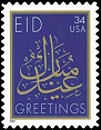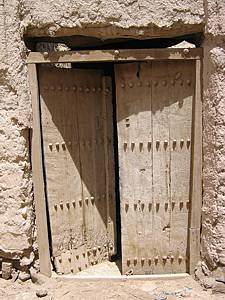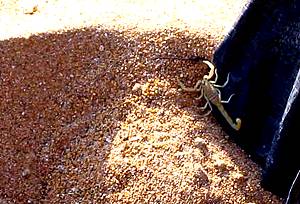
Artwork for this 34-cent, domestic-rate stamp was done by renowned Muslim American calligrapher Mohamed Zakariya of Arlington, Virginia. On September 1, 2001 the U. S. Postal Service began sales of this first ever postage stamp honoring American Muslims.
Pronouned “eed moo-bar-ak”, this Arabic greeting is now being shared as Muslims congratulate each other and offer warm regards for the unique family holiday marking an end to the Holy Month of Ramadan. Eid is a generic Arabic term that means “holiday” or “festival.” Islam celebrates two Eid holidays, specifically known as Eid al-Fitr (Festival of Fast-Breaking at the end of Ramadhan) and Eid al-Adha (Festival of Sacrifice). The Arabic script on the US postage stamp above reads Eid Mubarak, a phrase literally meaning, “Blessed Festival!” and the appropriate answer is, Allah yubarak feek! – May Allah bless it for you also! The greeting can apply to either of the two celebrations.

Camping in the desert at “The Serangetti”
Eid al-Adha or the Feast of Sacrifice is the most important feast of the Muslim calendar, lasting for three days and commemorating Ibraham’s (Abraham) willingness to obey God by sacrificing his son. It concludes the annual Pilgrimmage to Mecca. According to the Quran, Ibrahim was about to sacrifice his son when a voice from heaven stopped him and allowed him to sacrifice a ram instead. Rather than Isaac as told in the Old Testament, Muslims believe the son to have been Ishmael “considered the forefather of the Arabs “born to Hagar, the Egyptian maid of Abraham’s wife Sarah who, finding herself not having children, arranged for Abraham to have a child through Hagar acting as a surrogate mother.

Searching for Doorways to Understanding
So what, you might ask, does this have to do with
Child and Youth Care? Like many of you, I knew very little about the
Eid holidays and their meaning, before moving to live in the Middle
East. So at a very basic level, many would claim that not knowing
something can be a worthwhile reason for learning new information.
Second, I think it’s interesting to note how three major religious
traditions – Jewish, Muslim and Christian – recognise the same story of
sacrifice involving Abraham who was said to have been directed by God to
go out to a special place and sacrifice his first son. It may be of
interest to learn that some have claimed this to be a Biblical or
Quranic illustration of infanticide. Thus, the festival of sacrifice – Eid al-Adha – signals an abhorrence of child abuse and
celebrates alternative pathways for living. So you see, this is an
important celebration about responsive Child and Youth Care practice!

Watch Out for the Wee Ya'ans!
Equally, there is cause for celebration about the unique cultural legacy the world has been offered through the children and ancestry of Abraham or Ibrahim. The father and families of half-brothers Ishmael and Isaac provide a symbolic dilemma for all Child and Youth Care workers. Daily we are faced with children and young people who are struggling with family dynamics that have become complicated through multiple marriages. They endure sibling rivalries that are frequently reinforced by favoured or discarded wives. They seek closer involvement with absent fathers who are perhaps working or giving priority to others elsewhere, and where greater family participation in decision-making in the lives of children is urgently required.
Thus, I hope you can see that at both a symbolic level as well as at a practical level, it is important exchanges best wishes and Eid Mubarak – always remembering the importance of “taking care”!